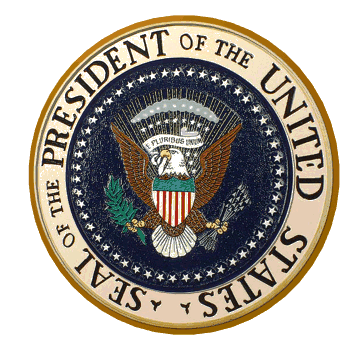 TheUSAPresidents.com
TheUSAPresidents.com 
 TheUSAPresidents.com
TheUSAPresidents.com 
The Vice President of the United States is a position that seems very important. However, that's not always the case.
Vice Presidential seal
When the Constitution was originally created, presidential elections were different. Each elector in the electoral college back then would choose two different candidates for president. The first place winner would be president, and second place vice president. However, back then, most people were more loyal to their states than the federal government, and the Founding Fathers knew this. Therefore, they banned electors for choosing two candidates from the same state. To allocate for this, the vice presidency was created. It also settled a dispute as many of the Founding Fathers felt the Senate should choose its president.
By 1796, the first two political parties had formed, the Federalist party and the Democratic Republican party formed. In the 1796 election, the two candidates, Federalist John Adams and Democratic-Republican Thomas Jefferson were bitter rivals, fighting for the presidency. In the end, John Adams ended up placing first, becoming president. Jefferson, on the other hand, came in second, which meant he became vice president. That meant that bitter political rivals of the opposite parties had to awkwardly work side-by-side for four years. Due to this, the twelfth amendment to the US Constitution was ratified and created the election rules we still have today.
In 1840, William Henry Harrison defeated incumbent Democrat Martin Van Buren. Harrison was criticized for his age, as he was 68. He was called "granny" by opponents. Ironically, though, just one month after Harrison took office, Harrison died on April 4, 1841. It is the shortest tenure for a president ever. A brief "national schism" then ensued as to what would happen next. The Constitution said that "In Case of the Removal of the President from Office, or of his Death, Resignation, or Inability to discharge the Powers and Duties of the said Office, the Same shall devolve on the Vice President". With this vague language, many believed that the vice president, John Tyler, was to only be acting president, and that a special election was to be held to elect a new president. Tyler, though, remained firm in his stance that since he was the vice president, he was entitled to serve the rest of what would have been Harrison's term. Tyler ended up getting his way, and it was the commonly accepted tradition until it officially became law under the 25th amendment to the Constitution more than 100 years later. If Tyler had not taken his stance, American history would look very different. Presidents such as Theodore Roosevelt and Lyndon Johnson were both vice presidents that later became president due to their predecessors dying in office.
While the Vice Presidency seems like a very powerful position, it really isn't. It's more of a "just in case" position, rather than a very important one. The only important thing that the Vice President does besides being the next-in-line for the presidency is being a tie-breaking vote in the Senate and certifying election results.